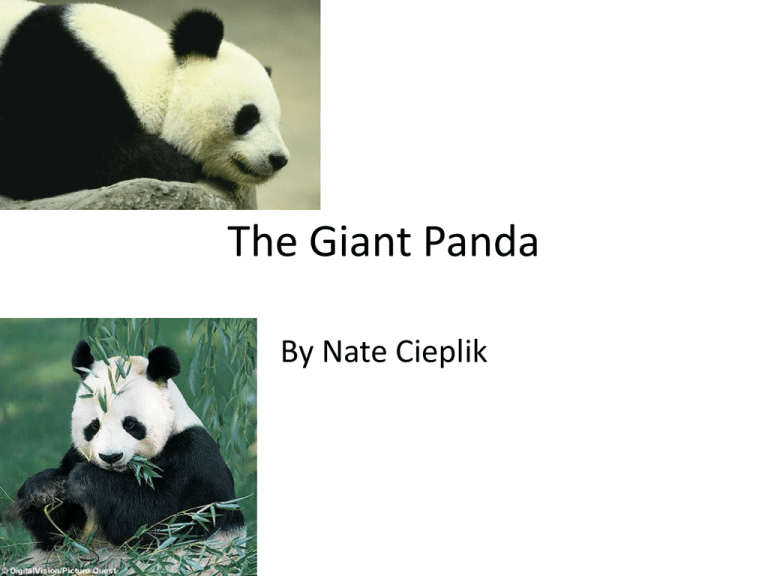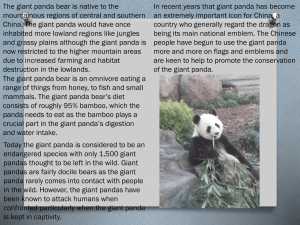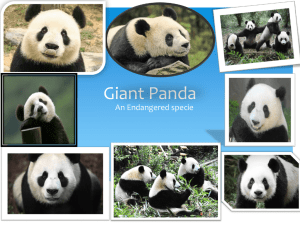Giant Pandas Nate Cieplik
advertisement

The Giant Panda By Nate Cieplik Structural Adaptations of the Giant Panda • One structural adaptation of the giant panda is having “six toes”. This is an important adaptation because it helps the giant panda hold the bamboo it eats and helps them pull the shoots and leaves off the bamboo stems. • A second structural adaptation of the giant panda is having a specialized digestive system. This is an important adaptation because it helps them swallow the hard tough bamboo. Also if they had a digestive system like other bears the bamboo could rip their digestive system. • A third structural adaptation of the giant panda is strong, muscular legs. This is an important adaptation because pandas are always moving because of their need for 20-40 pounds of bamboo a day. Even though they don’t move very far, they would have a higher likeliness not to survive with weak, flimsy legs because it couldn’t outrun predators as well as it could with strong legs. Structural Adaptations Continued • A fourth structural adaptation of the giant panda is a large head. This is an important adaptation because bamboo is very strong, and pandas need a larger than other bears because again bamboo is a hard, tough plant. Pandas need large strong jaw muscles. • A fifth structural adaptation of the giant panda is strong, smooth molars This is an important adaptation because the giant panda needs strong smooth molars because although most bears use their canine teeth to kill and eat its prey, the panda must use its molars because of the toughness of the bamboo. Behavioral Adaptations of the Giant Panda • One behavioral adaptation of the giant panda is slow movement or pace. This is an important adaptation because bamboo has little nutritional values, so the panda conserves energy by moving slowly. But if a predator (such as a human) was hunting a panda, it is capable of moving fast. • A second behavioral adaptation of the giant panda is marking territory using scent markings and claw markings. This is an important adaptation because by leaving claw marks on trees the giant panda sharpens and cleans their nails and also wards of strangers. By leaving scent markings the panda also wards off strangers. Behavioral Adaptations continued • A third behavioral adaptation of the giant panda is beginning to climb trees at age six months. This is an important adaptation it helps them get ready for their adulthood when they have to climb trees to get bamboo. This also helps them survive because if a predator attacks them while they are young they can climb a tree to get away from their predator. • A fourth behavioral adaptation is not getting fierce until cornered. This is an important adaptation because it gives its predators the illusion that it is defenseless and weak. When cornered the giant panda is anything but defenseless and weak. This helps the giant panda because its predators underestimate its power, so they might not attack it so hard. Habitat of the Giant Panda • The giant panda lives in the forests on mountains. • It lives in China. • One fact about the panda’s habitat is that it rains/mists a lot in a lot in it. This hides the giant panda from wild dogs that would have eaten it because the mist/rain helps camouflage them. • Another fact about the giant panda’s habitat is that it can be up to 10,000 above sea level. It needs evergreen forests to hide in, bamboo forests for food, and small animals to eat in its habitat. It would be difficult for a human to consistently live at that altitude. The Giant Pandas Diet • The giant panda is a herbivore and typically eats bamboo. • It also eats small animals that can be caught easily. • One fact about the panda’s diet is that it is made up of 99% bamboo and 1% small animals. • Another fact about the giant panda’s diet is that they need to consume 20-40 pounds of bamboo a day. That is equal to 80-160 hamburgers! Food Chain Sun Bamboo Giant Panda Wild Dog Resources • I used Giant Pandas by Lenore Franzen. • I also used the Smithsonian National Zoological Park website, and the bioweb website.











